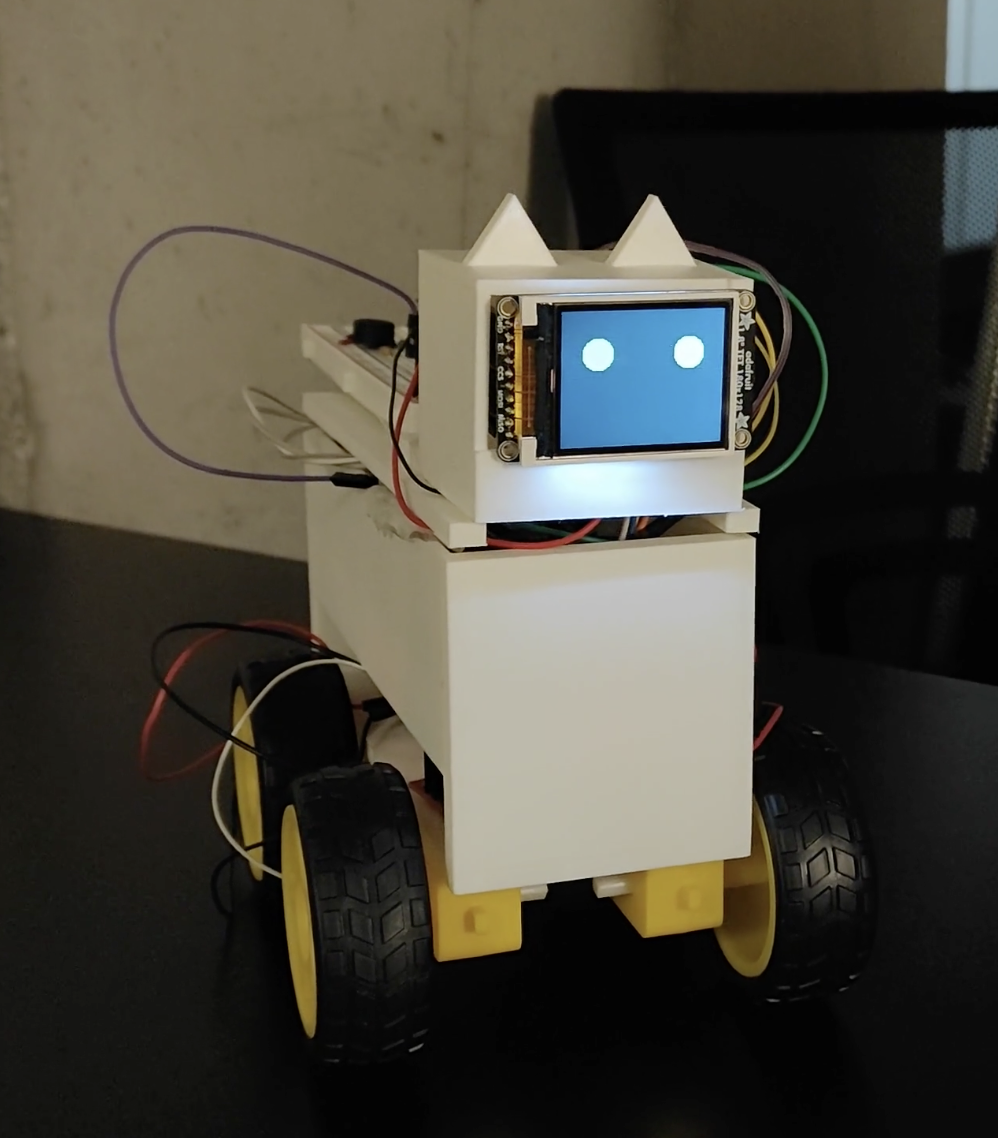ESE5190 Final Project - Team 9-eighty five
Team Members
- Tian Zhang
- Xinyi Wang
Project Video
Project Introduction
People often experience boredom and decreased concentration during prolonged periods of solitary work and study. This common issue not only affects productivity but also impacts mental well-being, potentially leading to stress and reduced learning efficiency.
Our goal is to develop a cat bot which has two modes: one is focus mode, in which the cat bot does not make any sound or move, only subtle facial expressions. The other is the interaction mode, in which the cat bot will have rich facial expressions and behaviors.
We hope to switch between these two modes through timed alarms, using focus mode when people need to focus on work or study. After a fixed period of time, the cat bot will sound an alarm to remind people to rest and interact with them.
Project Image

Results
Software Requirements Specification (SRS) Results
SRS 01 The system shall correctly collect and process the following input signals: Microphone data, Photoresistor data and Pressure sensor data.
We can correctly collect photoresistor and pressure sensor data, and use different channels of ADC tp read them.
Due to the amplifier circuit not being implemented in the ideal state, we were ultimately unable to use the microphone as an input component.
SRS 02 The system shall accurately output control signals required by actuators: Motor drive signals, LCD display control signals and Buzzer sound signals
We can use the L298N to drive the motor, enabling the car to perform four types of movements: moving forward, moving backward, rotating, and oscillating back and forth.
By using timer2 to generate PWM We can control the buzzer to sound.
We can control the LCD to display six different facial expressions. Here are some of them.




SRS 03 The system shall automatically switch working modes in the following cases: Switch to Focus Mode when setting alarm, Switch to Interactive Mode when alarm rings
We use pin change interrupts to switch modes and set the alarm.
SRS 04 The system shall be capable of displaying at least 5 different expression states
The LCD can display six different facial expressions, with transitions added during the expression changes.
SRS 05 The system shall provide accurate timing function: Support countdown from 1-120 minutes, Timing error within ±1 second/hour
The system can countdown from 1-120minutes.
Hardware Requirements Specification (HRS) Results
HRS 01 Project shall be based on two ATmega328P microcontrollers
We simplified the hardware circuit by using an extended port to solve the problem of insufficient pins, and also switched the channels of the ADC to read the values of two sensors in a short time. Therefore, in the end, we only used one ATmega328PB.
HRS 02 A 1.8” 128x160 TFT LCD shall be used to display the “mood” of the cat.
Completed.
HRS 03 A photoresistor shall be used to determine whether the cat is sunbathing.
Completed.
HRS 04 A Pressure sensor shall be used to determine whether the cat is being touched.
Completed.
HRS 05 A microphone shall be used to determine if the noise is loud enough to wake the cat up.
Due to the amplifier circuit not being implemented in the ideal state, we were ultimately unable to use the microphone as an input component.
HRS 06 A motor shall to be used to simulate the cat’s movement.
Completed.
HRS 07 A buzzer needs to be used to emit a sound to remind the owner to spend time with the cat.
Completed.
Hardware and software implementation


Conclusion
What did we learn from it?
In general, we have learned about the process of microprocessor development, including hardware, software and their coordination.
Technically speaking, We learned how to use extended ports (PCF8574) by i2c, how to use 2 channels of one ADC on a single board and how to manage many different logics.
What went well?
Use two sensors and a button to control the cat’s facial expressions and movements.
What accomplishments are we proud of?
We are proud of the 3D printing of our cat (everyone likes our cat and her cute ears) and the facial expressions we designed (including 6 expressions and a vivid blink).
What did we learn/gain from this experience?
We learned how to collaborate with teammate and to solve problems together.
Did we have to change your approach?
At first, we planned to use two ATmega328PB boards, because one board doesn’t have enough IOs and we thought we need 2 ADCs from two boards. After talking to Nick, we used just one board and a extended port, decreasing the complexity of our circuit and hardware.
What could have been done differently?
We can use other types of sensors or components for light and pressure sensing. We conservatively chose resistive components to read a voltage to sense the input signal. In fact, we have plenty of time to try new types of components.
Did we encounter obstacles that we didn’t anticipate?
We encountered many hardware problems, for example: we can’t load codes to our board, and we had changed 3 boards. Also, the LCD sometimes can’t display the correct facial expressions or just blank, it could be due to poor connection.
What could be a next step for this project?
We can add more sensors to our cat so she can do more interactions according to our actions, like distance sensors and microphones. We can use motors which can change velocity. We also want to replace with a larger LCD and a bigger shell.